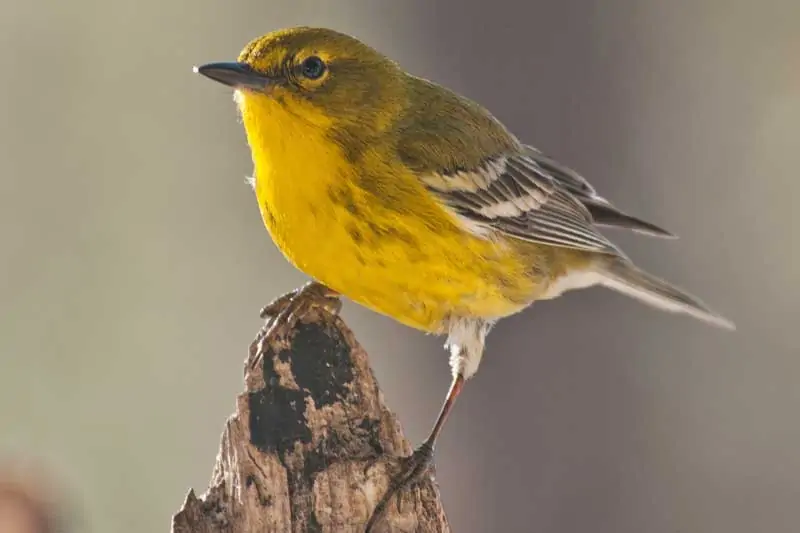Bluegrass music, country music, southern comfort foods, and horse racing are just a few of the things that make the South famous. These southern states also have a wealth of bird-watching possibilities. You’ll discover a considerable amount of variety no matter if you’re interested in birds of prey or songbirds. In this lesson, we’ll cover all of the various Warbler species in Tennessee and Kentucky, as well as when to find them.
36 SPECIES OF WARBLERS IN TENNESSEE AND KENTUCKY
In Tennessee and Kentucky, there are 36 different species of warblers to be found. They may be discovered throughout the breeding season, during the winter, or while migrating. To determine when to search for warblers in the volunteer and bluegrass states, we divided this page into three sections.
The majority of these Warbler species may be found across the Southeastern United States, even if we’re focusing on the states of Tennessee and Kentucky in this article. These species may be found in neighboring states such as Georgia, Mississippi, Alabama, Arkansas, Missouri, Virginia, and North Carolina. Any species on this list may be found in your state, so check with allaboutbirds.org.
14 Warblers Found in TN and KY During Breeding Season
1. OVENBIRD
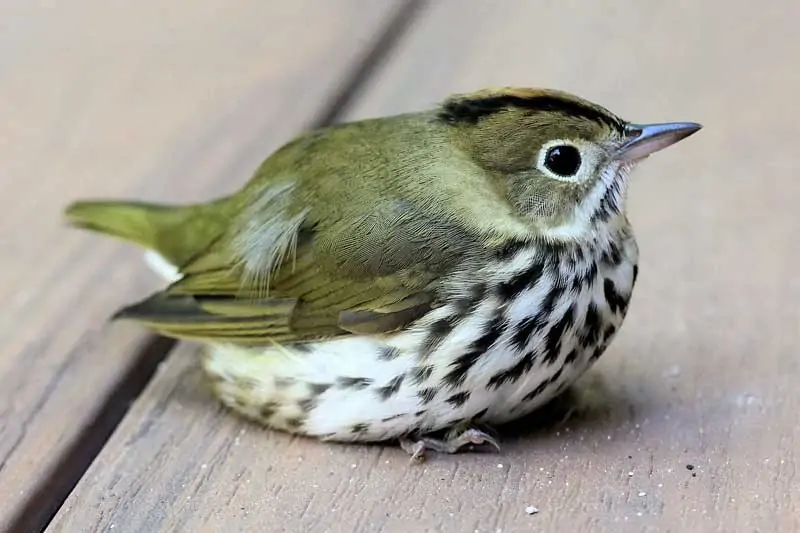
With greenish-brown plumage and a white belly with black markings, ovenbirds are on the bigger end of the warbler spectrum. They’re likely to forage on the ground in a variety of woodlands with deep canopy cover.
2. WORM-EATING WARBLER
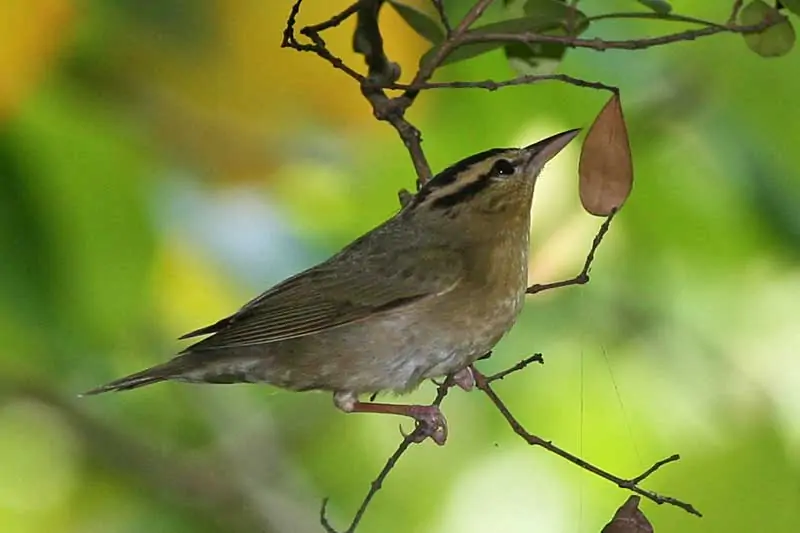
For their propensity to consume a lot of caterpillars, the Worm-eating Warbler gets its name. The olive coloration of these tiny songbirds contrasts with their black head stripes. They lay their eggs in the undergrowth beneath the trees’ thick undersides.
3. LOUISIANA WATERTHRUSH
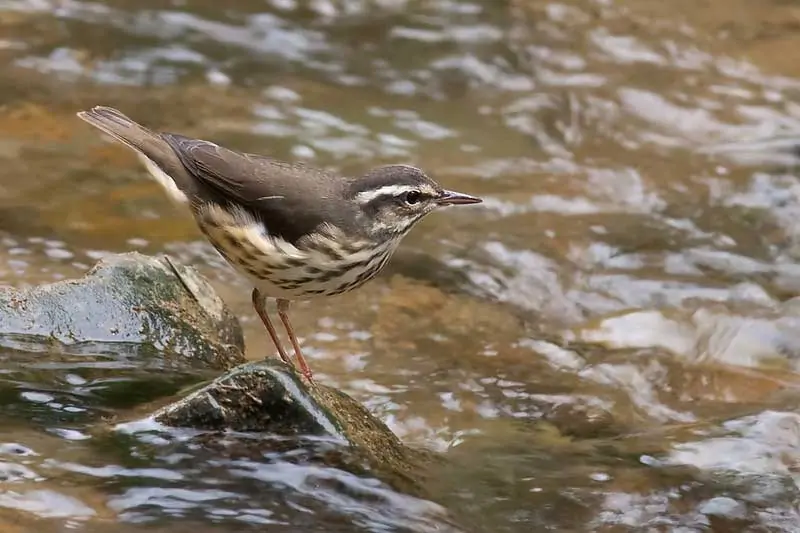
In woodlands near streams, Louisiana Waterthrushes may be found. They’re well-known for bobbing their rears up and down near the water’s edge. These birds are excellent stream health monitors because they are so linked to the water.
4. BLACK-AND-WHITE WARBLER
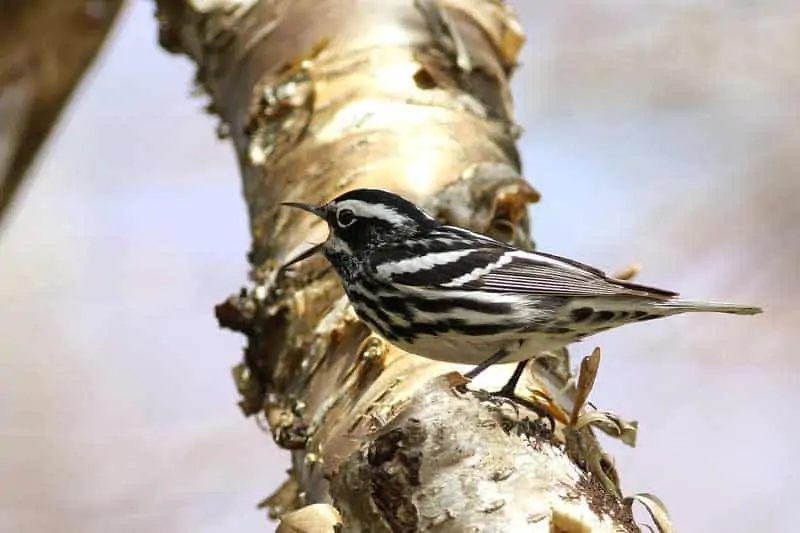
These medium-sized warblers have boldly colored, black and white plumage, as their name suggests. They monitor for insects that may be hiding in the wood beneath the tree bark. Look for them in both mixed and deciduous woodlands.
5. PROTHONOTARY WARBLER
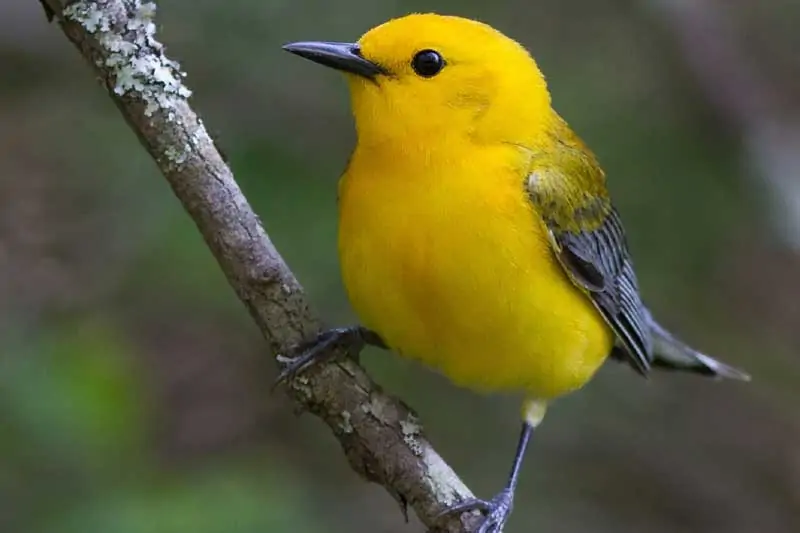
While their tails and legs are smaller than other warblers, Prothonotary Warblers are big warblers with heads and bills to match. This bird’s bright yellow plumage stands out against its gray wings, making it easy to see. In woodlands and wetlands, Prothonotary Warblers are known to forage near water.
6. SWAINSON’S WARBLER
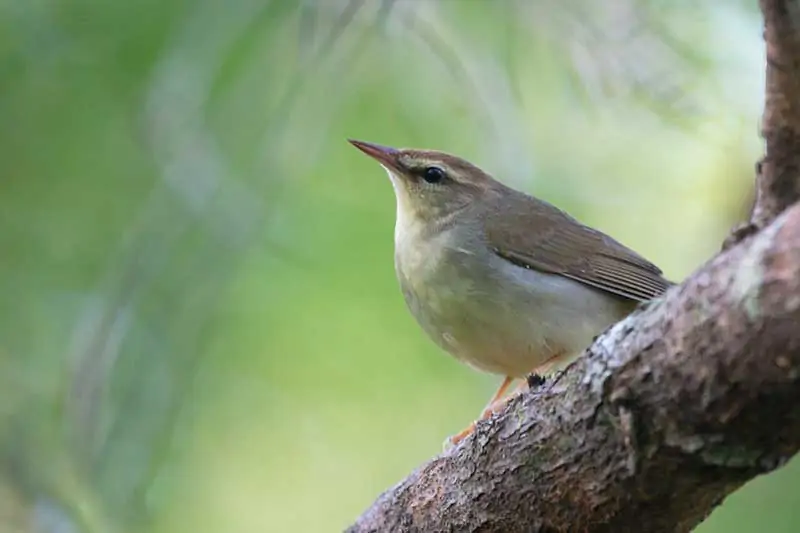
Finding Swainson’s Warblers may be challenging, but hearing them is often simple. They prefer to stay hidden among the understory of woods and have a light brown coloration across their bodies. The long bills of these warblers are used to flip over leaves on the ground in a unique way of foraging.
7. KENTUCKY WARBLER
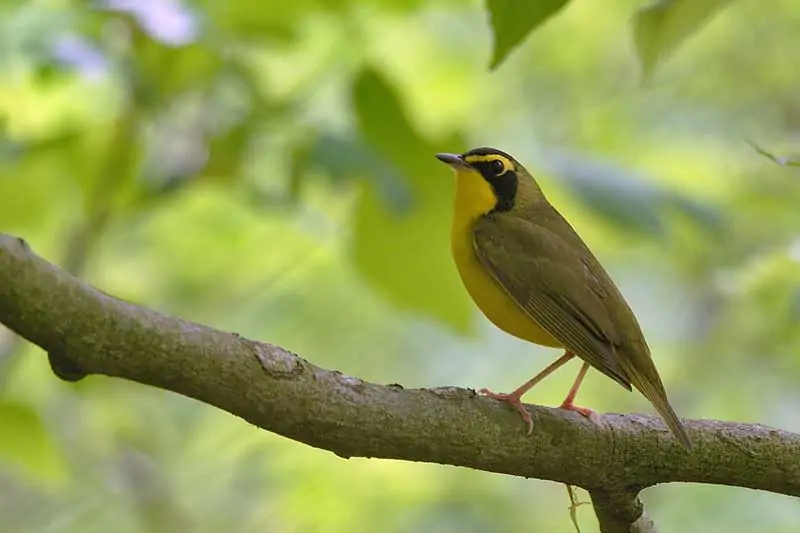
These loud, frequent callers are difficult to spot in the wild, but they make a bright yellow warbler. They spend a lot of time in the dense undergrowth of woods and forests, on the ground. Kentucky Warblers, like Swainson’s Warblers, like to hunt for insects in leaf litter.
8. COMMON YELLOWTHROAT
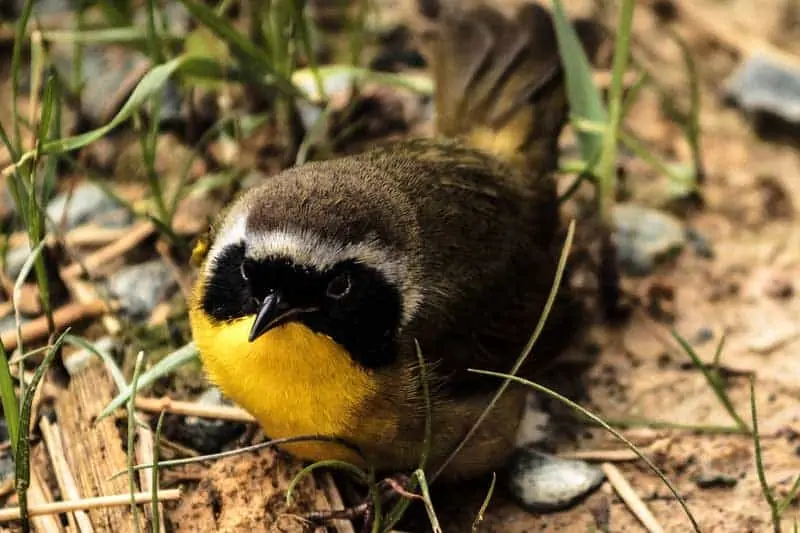
Along the margins of marshes and swamps, Common Yellowthroats are common. During the summer, listen for their frequent ringing calls, and look for a little yellow bird with a black bandit mask on its face. This group covers North America from coast to coast.
9. HOODED WARBLER
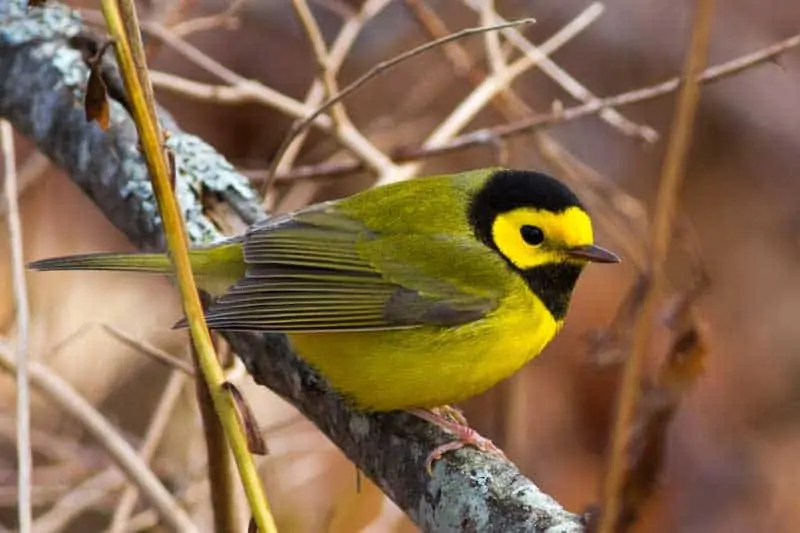
The bright yellow plumage of Hooded Warblers, like that of Kentucky and Prothonotary Warblers, is distinctive. Except for a wide yellow stripe that runs across their foreheads, their heads are black. In the woods, look for them in the understory.
10. NORTHERN PARULA

The yellow chests and chins of these small warblers contrast with greenish-gray uppers, giving them a unique look. Forests covered in lacy plants like Spanish moss attract Northern Parulas. They’re usually found in the highest branches of trees.
11. YELLOW WARBLER
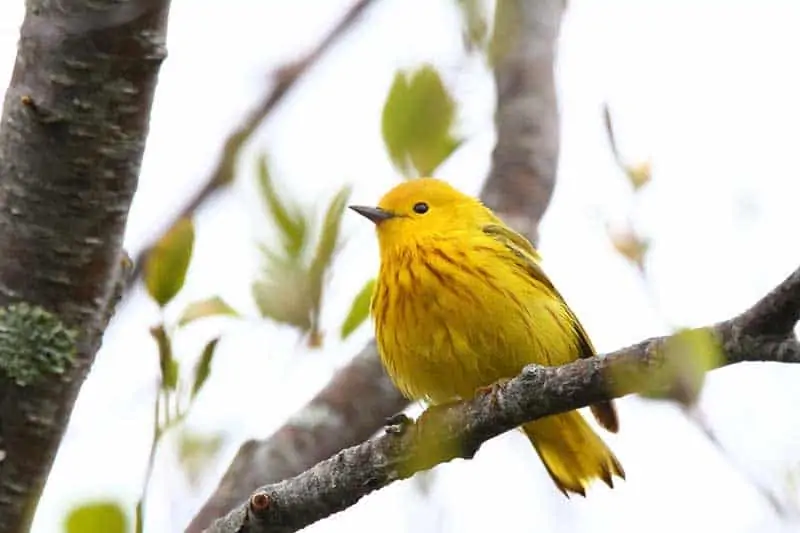
The Yellow Warbler is the most colorful of all the warblers with yellow plumage. These tiny warblers are often spotted in willow trees and thickets along streams’ borders and in marshy areas, where they are synonymous with wetlands. Another common warbler species is the Yellow Warbler, which may be found across the United States.
12. PINE WARBLER

Pine Warblers prefer pine woodlands, as you may have deduced from their name. The bodies are dull and the wings are tan. Listen for their trills, but watch the pine tree’s towering limbs, where they often search for seeds and insects. The eastern and southeastern sections of the United States are where they live.
13. YELLOW-THROATED WARBLER

Yellow-throated Warblers, named for their bright yellow throats against their mostly gray bodies, are primarily found in the southeast. It also feeds on insects in bark and seed clusters in the upper canopy of trees, which is another bird that frequents.
14. PRAIRIE WARBLER

Prairie Warblers are actually found in scrubby and overgrown fields, as well as on the edges of forests, than imply by their name. Their bodies are yellow, and their wings have dark streaks.
Warblers in Kentucky during winter
15. YELLOW-RUMPED WARBLER

Only one warbler, the Yellow-rumped Warbler, migrates to Kentucky throughout the winter from Tennessee and other surrounding southeast states. During the winter migration, substantial numbers of these warblers congregate in trees and shrubs, making them easy to spot.
Warblers in Kentucky during migration
During migration, the bulk of these warblers are passing through. While they aren’t around for long, during their migrations, they may be seen in Tennessee, Kentucky, and other nearby states.
16. GOLDEN-WINGED WARBLER
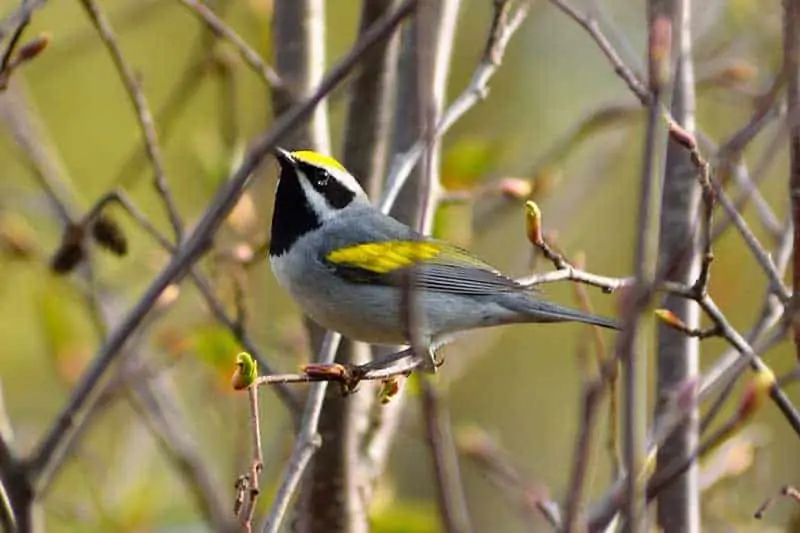
The Golden-winged Warbler is distinguished by its bright yellow head and wings, as well as its distinct gray plumage. They breed in Minnesota but go south to Central America during the fall.
17. BLUE-WINGED WARBLER

Blue-winged Warblers are known for their blueish-gray wings and tail. Their heads and bellies are a lovely canary-yellow coloration.
18. TENNESSEE WARBLER

The boreal woods of Canada, where the Tennessee Warblers breed, are home to this kind of warbler. They have a greenish-gray plumage that isn’t as bright as other warblers and has little reds in it.
19. ORANGE-CROWNED WARBLER

Another dull-colored warbler is the Orange-crowned Warbler. Their orange crown is only really visible when they get excited and perk up their feathers, despite the fact that their name suggests that they have some sort of orange coloration on their heads.
20. NASHVILLE WARBLER

Nashville Warblers have a bright yellow plumage. Their eyes are surrounded by white circles, which gives them the appearance of having enormous, round eyes. Alexander Wilson, a Scottish-American poet, naturalist, and artist known as the “Father of American Ornithology,” was the first to notice the Nashville Warbler. In 1811, he first saw the bird in Nashville, Tennessee, as you might have guessed. It may be found in Tennessee, Kentucky, and a number of other southern states during the migration season.
21. CONNECTICUT WARBLER
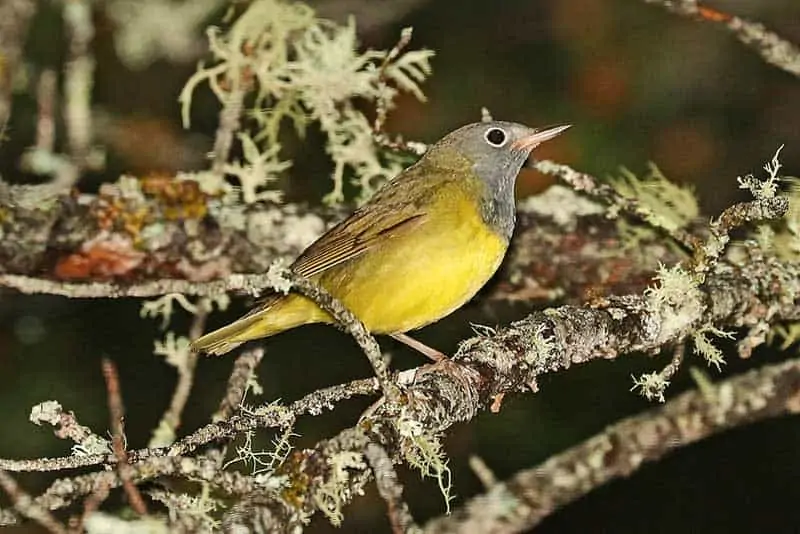
This warbler may be difficult to locate. The Connecticut Warbler is well-known for being exceptionally difficult to locate, not just during migration seasons but also throughout the year. They feed on the ground and in thick underbrush.
22. MOURNING WARBLER
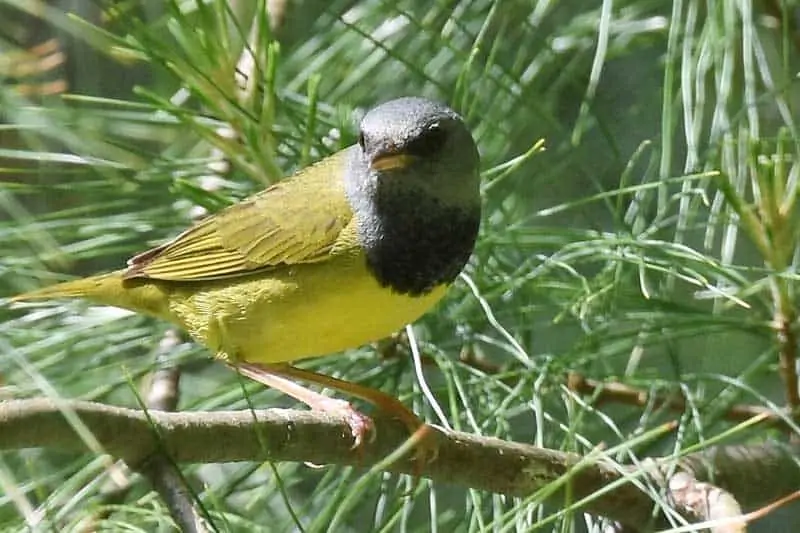
Mourning Warblers are frequent, but they’re difficult to locate, much as Connecticut Warblers. Males like to sing early in the morning during breeding season, but they are quite calm throughout migration and winter.
23. AMERICAN REDSTART
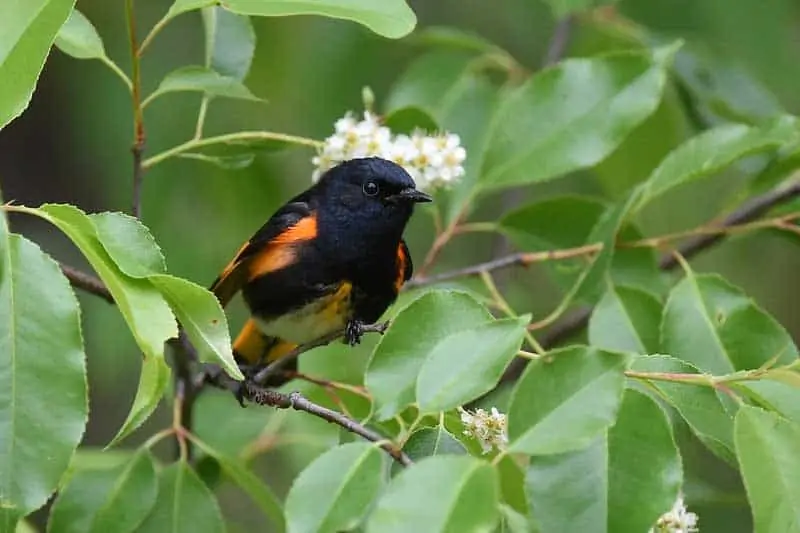
The black and orange colors of male American Redstarts are striking. They’re fast-flashing birds that pursue insects by hopping from limb to limb.
24. KIRTLAND’S WARBLER
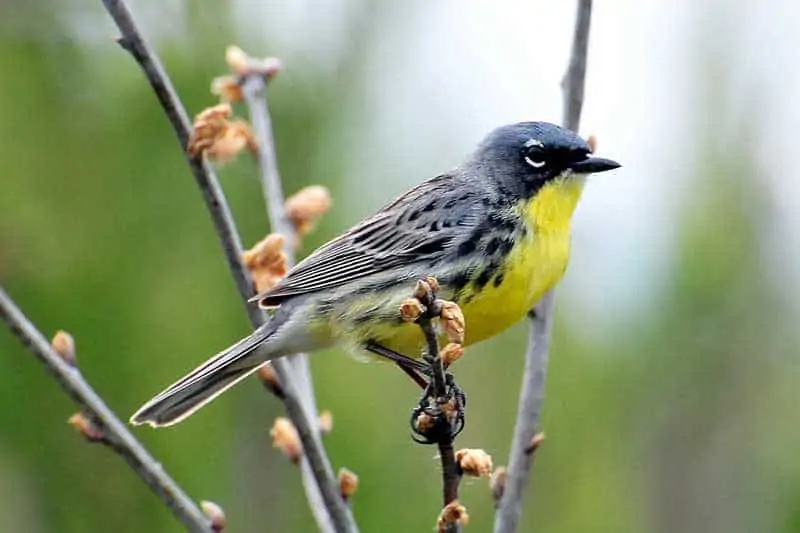
It’s unusual to see a Kirtland’s Warbler. During migration, they can be found solely in eastern Kentucky and Tennessee. Otherwise, they need pine woodlands and open regions in burnt woodlands for their unique habitats. This species is only found in a few eastern states, and its distribution is very limited. Apart from TN and KY, it has no presence.
25. CAPE MAY WARBLER

One of the most spectacular plumages seen in Cape May Warblers is their. Their chests have black tiger stripes and their eyes are ringed in orange markings, and their bodies are generally a brilliant yellow.
26. CERULEAN WARBLER

The beautiful, sky-blue color of Cerulean Warblers attracts them. In the upper levels of tree canopies, they spend their time close to the sky. They’re frequently seen in mixed-species flocks throughout the winter in South America.
27. MAGNOLIA WARBLER

During the breeding season, Rose Warblers are usually found in coniferous forests, but when they migrate, they may be found in any kind of forest. Their bright yellow bellies with black streaks will help you find them.
28. BAY-BREASTED WARBLER

The way Bay-breasted Warblers change colors throughout the year is unusual. In the summer, their plumage is mostly gray, but in the autumn, their plumage changes to green and white.
29. BLACKBURNIAN WARBLER
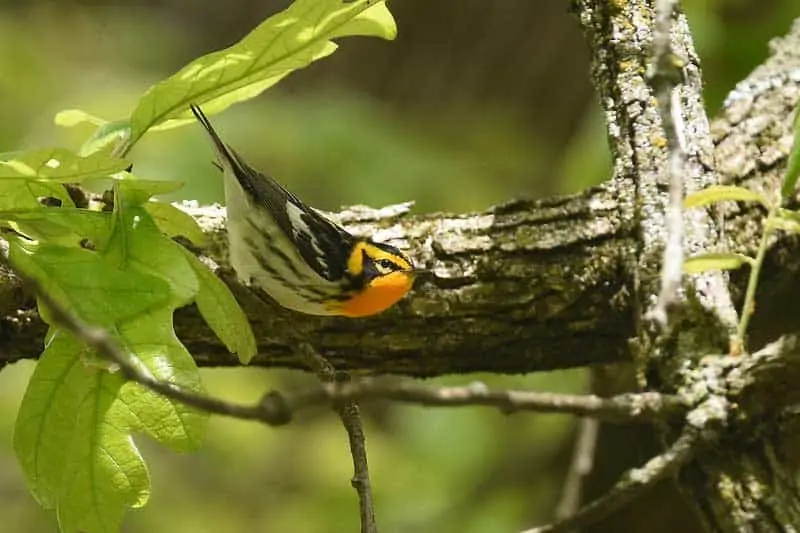
The uppers of Blackburnian Warblers are black and white, with orange faces with black markings. The birds’ plumage is very distinctive. They’re most often seen in the upper levels of the forest, although they may be seen at lower elevations during migration. Although there is a small breeding population in the easternmost parts of these states, the bulk of their range in KY and TN is migratory.
30. CHESTNUT-SIDED WARBLER
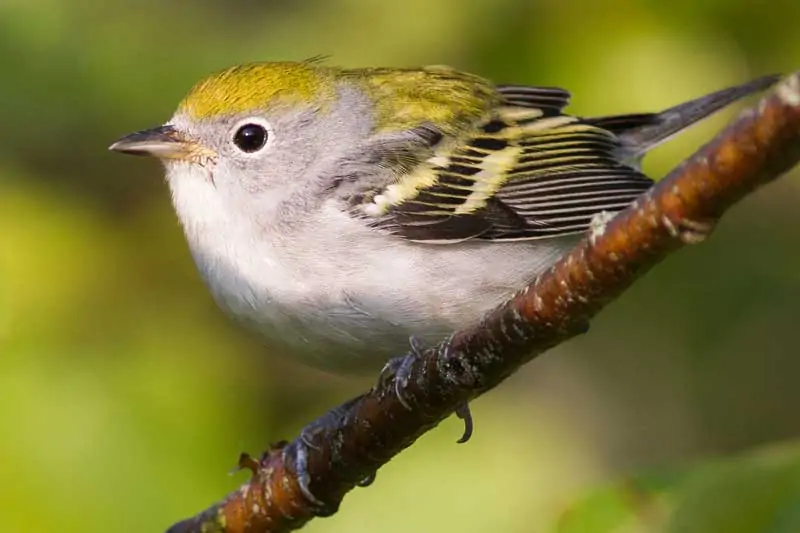
Because of the chestnut-brown streaks running down the sides of it’s belly, the Chestnut-sided Warbler is called that. It meets up with the same mixed-species flock it foraged with the year before during its winters in Central America.
31. BLACKPOLL WARBLER
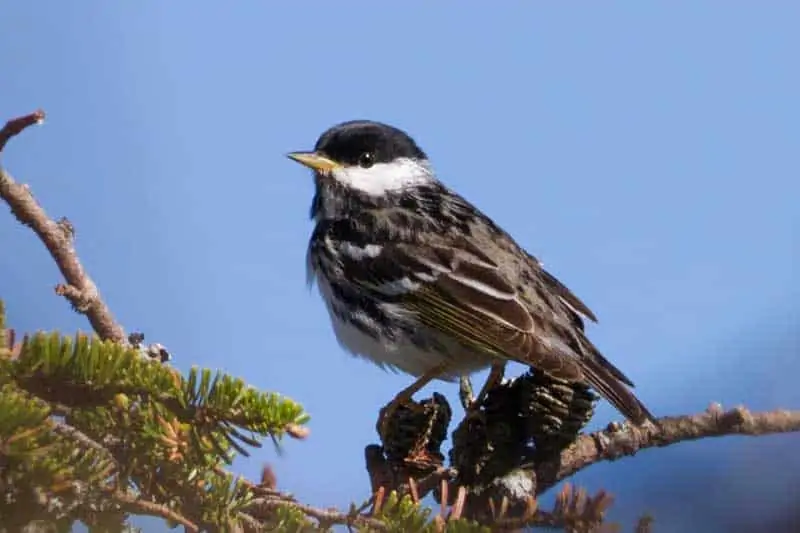
The Blackpoll Warbler’s plumage is easily recognized due to its distinctive black and white streaking. During their migration, they’re long-distance wanderers who take different routes in the spring and fall.
32. BLACK-THROATED BLUE WARBLER
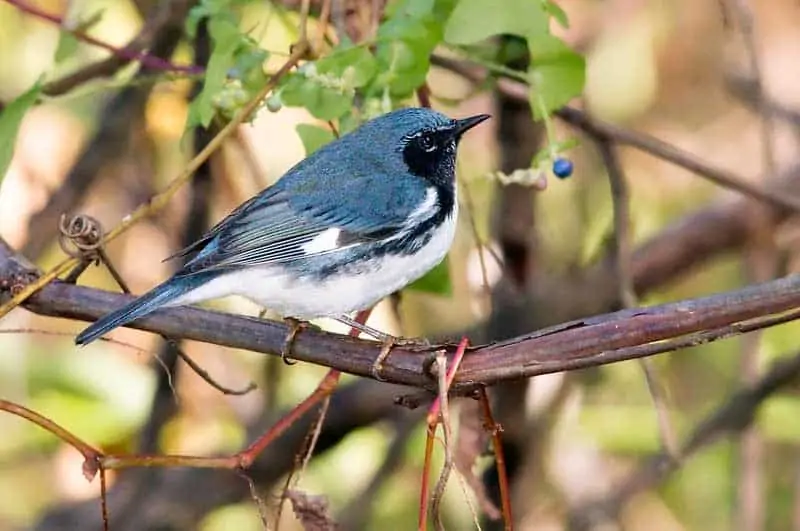
With a solid white belly and black faces and necks, Black-throated Blue Warblers look similar to Cerulean Warblers. Females are primarily olive-colored, and they lack any blue pigmentation. Males and females were formerly thought to be distinct species due to their differences. Some breed, but mostly pass through the states on migrations, may be found in eastern KY and TN.
33. PALM WARBLER

Palm Warblers are known for spending their time on the ground foraging, so don’t expect to find one in the trees. When they walk along the ground, they exhibit an unusual tail wagging behavior.
34. BLACK-THROATED GREEN WARBLER

The male Black-throated Green Warbler may sing hundreds of songs per hour, making them exceptional vocalists. Some breed in eastern KY and TN, and they have a distinctive call that almost sounds like “trees trees, I love trees.”
35. CANADA WARBLER
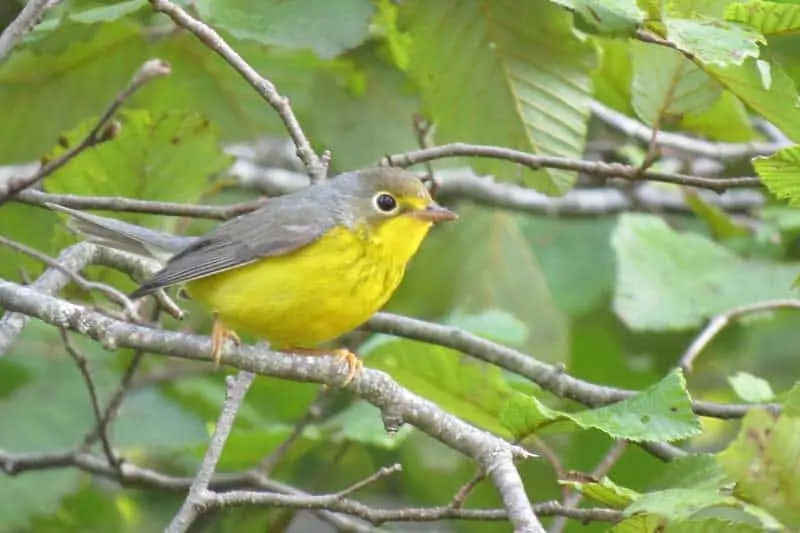
The Canada Warbler spends relatively little time in Canada. It tends to come late and leave early during the winter in South America, despite its breeding there. However, in the mountains of eastern Tennessee, there is a tiny pocket of breeding Canada Warblers.
36. WILSON’S WARBLER
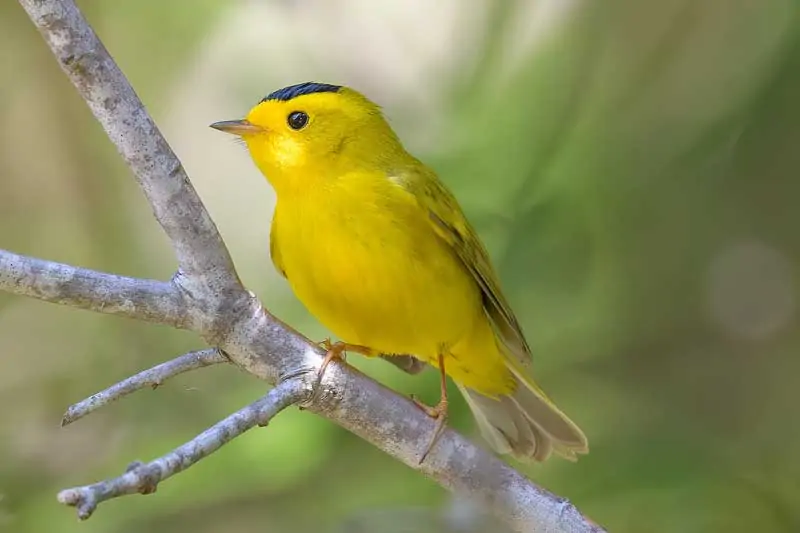
Because of their sunny yellow bodies and distinct black head on their heads, Wilson’s Warblers are one of the easiest warblers to identify. These active birds flit back and forth from tree to tree, making it difficult to spot one.
